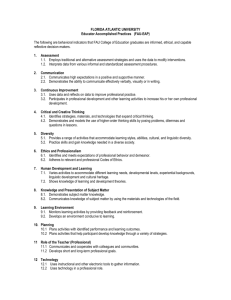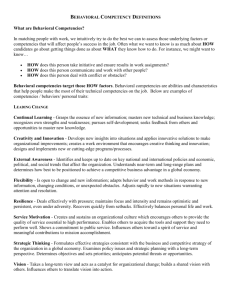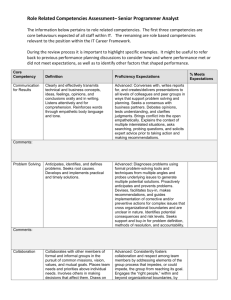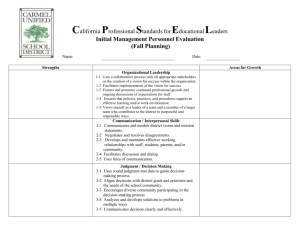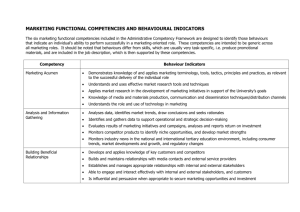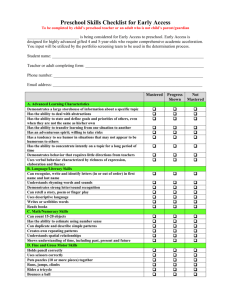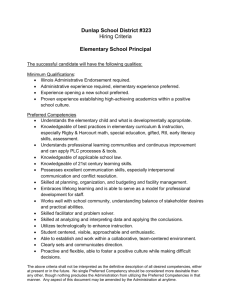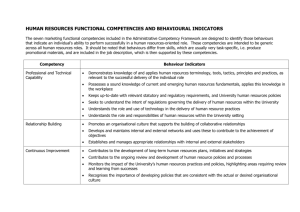Competency List - Up Your Leadership
advertisement
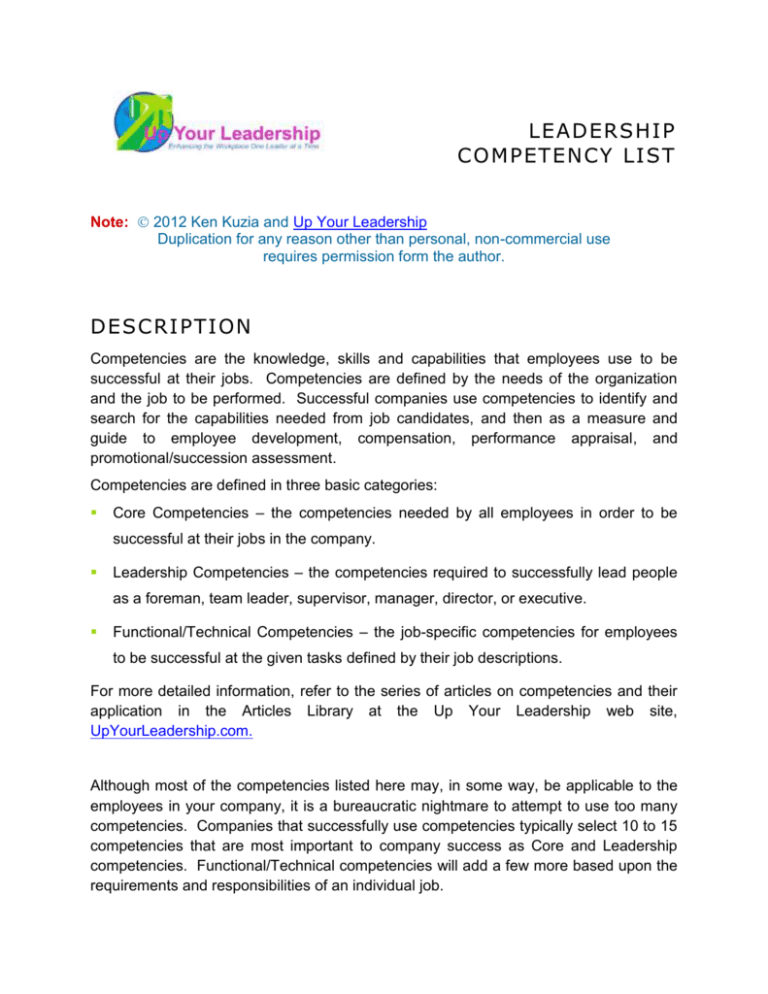
LEADERSHIP COMPETENCY LIST Note: 2012 Ken Kuzia and Up Your Leadership Duplication for any reason other than personal, non-commercial use requires permission form the author. DESCRI PTION Competencies are the knowledge, skills and capabilities that employees use to be successful at their jobs. Competencies are defined by the needs of the organization and the job to be performed. Successful companies use competencies to identify and search for the capabilities needed from job candidates, and then as a measure and guide to employee development, compensation, performance appraisal, and promotional/succession assessment. Competencies are defined in three basic categories: Core Competencies – the competencies needed by all employees in order to be successful at their jobs in the company. Leadership Competencies – the competencies required to successfully lead people as a foreman, team leader, supervisor, manager, director, or executive. Functional/Technical Competencies – the job-specific competencies for employees to be successful at the given tasks defined by their job descriptions. For more detailed information, refer to the series of articles on competencies and their application in the Articles Library at the Up Your Leadership web site, UpYourLeadership.com. Although most of the competencies listed here may, in some way, be applicable to the employees in your company, it is a bureaucratic nightmare to attempt to use too many competencies. Companies that successfully use competencies typically select 10 to 15 competencies that are most important to company success as Core and Leadership competencies. Functional/Technical competencies will add a few more based upon the requirements and responsibilities of an individual job. We made no effort to list or define specific examples of functional/technical competencies although some listed here might fall into that category. The range of possibilities for functional/technical competencies is too large to include here. Such a list would include competencies for the use and level of use for machinery, professional expertise, processes, software, safety, tools, vehicles, and others. ACCOUNTABILITY & EMPOWERMENT BUILDING APPRAISING PERFORMANCE Takes ownership for the consequences of one’s own actions & decisions Takes responsibility for making decisions, owns outcomes, and does not shift focus of blame on others in case of a failure Completes self-assessment to identify development opportunities and strengthens one’s own development, growth, and capabilities Encourages and strengthens the development, growth, and responsibility to build self-esteem of others Asks productive questions as well as reflective questions that encourage thinking Sets realistic expectations for performance based on employee’s capabilities and development aspirations Identifies information and other resources that are needed, and ensures that boundaries are removed to make them available Infuses vision, values, and goals into daily work Challenges others to take reasonable and calculated risks Teaches others how to identify self-imposed barriers and how to overcome them Uses a three-part scale to appraise performance: Fails to Meet, Meets, & Exceeds Expectations Sets and communicates fair and reasonable performance expectations at the beginning of the appraisal period Measures outcomes and reinforces expectations throughout the performance period Measures actual performance results against expectations using facts and observations Records and retains any facts, measures, observations or any other pertinent performance details throughout the performance period Provides periodic feedback regarding performance quality Writes a performance appraisal with observations and facts Compares performance against the expectations set at the beginning of the performance period Discusses an appraisal with an employee and reviews sources of facts, measures, and observations, then clarifies any questions Ties the prior period performance results to the next performance period’s continuous development objectives Makes realistic and accurate judgments about others Accurately evaluates the strengths and weaknesses of others, and understands their manner of thinking, acting, and behaving Accurately interprets body language, reticence, stress and emotions of CHANGE MANAGEMENT COACHING others: “reads between the lines” with people Defers making judgments until facts are gathered and analyzed Confronts own assumptions to avoid incorrect inference Juggles multiple priorities simultaneously Changes direction and priorities with little or no notice and does so successfully without complaint Is able to leave older, lower-priority tasks unfinished while moving on to newer, high-priority tasks with little or no notice Appropriately manages rapid and complex change Demonstrates support for innovation and for organizational change needed to improve the organization's effectiveness Initiates, sponsors, and implements organizational transformation Helps others to successfully manage organizational adjustments Communicates change requirements with measurements and milestones Makes the link between required changes and the business strategy to enhance understanding and commitment Leverages early adopters and manages “stallers” and resistors Builds a relationship based on trust and communication Gives clear definitions of expectations for results Provides support for all requirements Asks questions to fully understand the situation before making decisions Conducts tough or serious and focused conversations when required Separates self and self-interests from the employee’s situation Uses problem-solving and patience to get to the truth and real issues Empowers others to make their own decisions and encourages full accountability without complaint Helps others see themselves as important and valuable to the company Makes difficult issues discussable to get to the root of issues Accurately interprets body language, reticence, stress, and emotions to reads between the lines” with people Uses active listening skills Encourages conversation by asking questions and appropriate probing Encourages a trust-based exchange by accepting what others say without judgment, and by ensuring the whole story is heard Identifies the content as well as the context of a discussion Avoids errors by not making inferences but making fact-based decisions Allows others to have their truths (opinions and perceptions) Allows others to make decisions for themselves Chooses the right time to confront objectionable or poor behavior Confronts controversial or difficult issues in an objective manner COMMITMENT BUILDING COMMITMENT (SELF) COMMUNICATING EFFECTIVELY Explains the value of the task to the company, the owners, the employee, and the community, as appropriate Asks employees to make a promise to timely and full fulfillment of promises made Provides a compelling or inspired vision of what has to be accomplished Develops and invokes a self-starting attitude in others in the pursuit of a goal Motivates others to do their best Provides practical, concrete ideas, and methods to assist others in achieving their goals Asks for commitment upfront Senses and resolves hesitations to commit Manages delay in and resistance to commitment Rewards commitment and follow-through Seeks to understand requirements established for a job, before promising to deliver Makes a personal pledge to execute a specific task by a certain time, with full delivery Makes agreements, pledges, and promises without bowing to external influences or pressures Motivates oneself from within to stay focused on delivering on promises Demonstrates personal involvement and engagement – “has skin in the game” Demonstrates acceptance and belief in action promised Understands and uses multiple forms of communication Alters communication approach based upon message, audience, and likely response Communicates successfully with all levels of subordinates, peers, and superiors Clearly conveys the message’s intent through artful use of vocabulary, clarity, and skill in understanding the situation and the audience Understands the importance, timing, and amount of communication needed in the given situation Listens actively and provides verbal and non-verbal feedback Stays on topic and pulls others back to the topic when attentions are diverted Exchanges ideas, opinions, information, experiences, and assumptions freely and with a truthful approach Expresses oneself clearly in conversations and interactions with others Engages others quickly by creating a safe environment for communicating Expresses oneself clearly in business writing Asks questions in a non-threatening manner to maintain a safe environment Accurately interprets body language, reticence, stress, and emotions of others “Reads between the lines” with people COMPETITIVE NATURE CONFLICT MANAGEMENT CONSISTENCY & RELIABILITY Analyzes conflicts and the basis for the issues before acting Looks for growth opportunities in face of adversity Approaches issues from multiple perspectives and with input of others Plans ways to act to improve or resolve the problem through collaboration Starts with a win-win perspective and attempts a collaborative solution Actively seeks to prevent harmful conflict Engages in managed contention to get to the best outcome Shifts strategy to negotiation, “lose-lose”, or “I win – you lose” if “win-win” and collaboration fail Is conscientious about delivering on personal and professional commitments Has predictable behavior rather than sporadic highs and lows Is punctual and is known for being punctual Says what is meant and does what is promised Works to be perceived as responsible, reliable, and trustworthy Is trusting and trustworthy unless the situation dictates otherwise Achieves a high level of performance that does not vary much in quality over time Stays steadfast in adherence to the one’s principles CORRECTING OTHERS Deals effectively in environment where consistently “winning” is critical Uses tenacity, boldness and a “want to win” attitude in dealing with highly competitive situations Changes strategies as situation dictates to ensure a winning outcome Competes only with external companies or vendors and encourage a collaborative environment within the company Demonstrates an eagerness to win, to succeed Uses competition to build focus and energy Ensures that department or group focus supports company success Chooses the right time to confront objectionable or poor behavior Confronts controversial or difficult issues in an objective manner Has non-emotional discussions about disciplinary matters Focuses on employee actions and decisions in practical ways to identify mistakes, corrective actions required, and points of learning Identifies the causes of success and failure in others and provides feedback in an objective and accurate manner Stresses fixing the problem and developing the person Addresses behavior and not an employee’s personhood Ensures that expectations for going forward are clear Makes an effort to help an employee maintain self-respect while discussing mistakes, errors, or failures CREATIVITY CUSTOMER FOCUS DECISION MAKING Views issues and problems from multiple perspectives Willing to take reasonable risks to try new approaches Has the ability to use imagination and challenge conventional thinking to develop new approaches, designs, or methods Adapts traditional methods, concepts, models, designs, technologies, or systems to new applications Devises new approaches to make improvements or solve problems Evaluates situations to identify opportunities for process improvement, waste reduction, and removing bottlenecks Identifies two or more solutions to ensure choice and increased probability of success Uses brainstorming process rules to enhance idea generation Avoids evaluating ideas until brainstorming is finished Encourages others to imagine, be innovative, and to take reasonable risks in trying new approaches Understands the needs, desires and motivations of customers and explains them to employees Delivers products and services that meet or exceed (internal or external) customer expectations Demonstrates concern for satisfying internal and external customers Communicates regularly with customers (or sales/marketing) to predict trends and needed changes Works to create what the customer will want in advance of the customer wanting it Understands the difference between customer satisfaction, needs, wants, and communicates difference to employees Measures or gets measures of customer approval and satisfaction on a regular basis and makes changes accordingly Communicates customer information to help employees understand company strategy, goals and action plans Develops a strong relationship with (or knowledge of) key customers Discusses customer expectations when decisions are made, policies are implemented, and employees are trained Is objective and fairly evaluates the different aspects of a situation Makes ethical decisions that takes into account all problem or situational aspects, components, or issues Simultaneously considers the needs of one's self, of others, and the company when making decisions Formulates accurate, intuitive perceptions about a situation and uses them in making a decision or taking action Consistently uses a specific decision making model or process to make decisions Makes difficult decisions in a timely manner Makes the final call when others won’t Takes reasonable, calculated risks when making decisions DELEGATING DETAIL ORIENTATION DEVELOPING OTHERS (TRAINING) DEVELOPING SELF Assigns responsibility fairly and equally based on employee capabilities Surrenders control (but not accountability) of a given situation to employees when delegating tasks Is comfortable in a situation where a significant portion of the responsibility for achieving a goal lies in the hands of others Conveys confidence in employees' ability to be successful especially when faced with challenging new tasks Assigns increasing responsibility and authority up to and slightly beyond the employees’ abilities to provide challenge and development Sees and pays attention to details Recognizes the component parts of a procedure or object, and verifies the correctness or error in an individual part or procedure Analyzes and challenges data before making important decisions Looks for patterns others don’t look for Conducts a “sense check” to ensure data are reasonable Maintains accuracy of data for future use Ensures others have considered details before moving forward Notices details and really cares about them Assesses strength and application of job-required knowledge & skills based on importance and requirements of the job Prioritizes development needs based on assessment Determines the best method for development (class, on-job-training, et al.) based on development needed and employee learning style Establishes a development plan including targets, time frames, methods, and required resources before beginning development Regularly measures development progress through observation, testing, performance measures, or instructor/mentor feedback Provides feedback following practice Determines when sufficient development has occurred, and employee is ready to apply learned knowledge and skill to position Provides appropriate follow-up and feedback to fully integrate skills Rewards learning successes to motivate additional or future learning Creates, uses, and documents progress in personal development plan Sets short and long-term development goals Assesses own skills and development needs on the basis of job requirements, company, customer, feedback, and technology changes Seeks feedback to identify skill and knowledge shortfalls Consistently seeks and obtains training and growth opportunities Creates a development plan with action steps that support structured progress and self-assessment Uses a variety of development assessment methods including 360° feedback, formal assessment, informal feedback, and mentors Determines when sufficient development has occurred, and is ready to apply learned knowledge and skill DIVERSITY MANAGEMENT Reviews one’s development plan and progress with one’s supervisor. Rewards one’s self when development goals are reached Does not allow unfair implications of prejudged information to enter into and affect an interpersonal relationship Inhibits and eliminates unfair implications of prejudicial information from entering into or affecting a work relationship Doesn’t allow a person’s class, race, sex, ethnicity, age, sexual orientation, or personal philosophy to cause bias against actions, potential, intentions, or attitudes of others Encourages productive and mutually beneficial interactions between employees Works to unleash and integrate the various experiences, ideas, and talents that employees bring to the job and company Demonstrates and promotes a sense of community and comfort with difference Promotes harmonious team member relationships, and intervenes when differences cause disharmony Solicits different opinions, ideas, and approaches and draws out different perspectives to gain the best outcomes Recognizes and discusses instances when diversity has enhanced outcomes DRIVE, (PERSONAL) EMOTIONAL CONTROL Demonstrates the desire to achieve, accomplish, or complete a task Drives to achieve better than the status quo Seeks fulfillment and reward from work Interprets problems or set-backs as challenges and opportunities to learn Drives hard but never over others Encourages others to excel Pushes people to excel but never pushes too hard or too far Recognizes and rewards employees that demonstrate personal drive Maintains a rational and objective demeanor in stressful or emotional situations Remains self-composed and never displays anger in a difficult situation Acts objectively, rather than impulsively or emotionally Acts without allowing emotions to get in the way of making objective decisions Gathers facts and does analysis before responding to emotionally charged situations Knows when emotionally flooded and withholds comment or action until emotions subside EMPATHY Understands how someone feels and imagines what it is like to be the other person in their situation or circumstances Perceives and understands the feelings, attitudes, and situations being experienced by others Notices, interprets, and anticipates the concerns and feelings of others EMPLOYEE TERMINATION ETHICAL LEADERSHIP FACILITATING FORUMS & FOCUS GROUPS and communicates this awareness compassionately Places oneself “in the shoes of others” and views a situation from their perspective Avoids allowing personal feelings and attitudes to get in the way of sensing the emotions and feelings of others Checks out (asks about or confirms) the emotional state of others to ensure appropriate interpretation before speaking or acting Maintains an environment of respect and ensures that team members are engaged and not marginalized Avoids marginalizing others Takes responsibility and ownership for the termination decision and demonstrates such by not blaming others Accurately describes the gap between the employee's behavior and expectations that caused the termination Uses tact and demonstrates respect for the employee throughout the termination process Ensures clear instructions are given to terminated employees about next steps, benefits, final pay, and further company communications Treats terminated employees’ questions with respect and answers questions appropriate to address Coaches terminated employees, if requested, on how to approach coworkers regarding the termination Watches for emotional stress, threats, or potential for injurious behavior and alerts HR or authorities, if required Refers terminated employees to Human Resources regarding specific benefit and reference questions Leads by making decisions, providing clear direction, establishing clear measures, and rewards Demonstrates trust in others and one’s own trustworthiness Is honest in communications and measurements Requires respect for others and the incorporation of differences: ideas, experience, approach, and style Demonstrates loyalty, humbleness, friendliness, approachability, and openness Demonstrates integrity by owning failures, being honest in measurements, and giving credit where due Manages by employing stewardship, empathy, inclusion, empowerment, and ending marginalization Follows rules, policies, and laws that apply to the company Establishes new or supports and communicates existing guidelines for group behavior Uses excellent meeting management techniques Makes the facilitation process clear, focused, and efficient Manages the overall meeting process including process and information management, participation, decision making, and recording FEEDBACK (GIVING & RECEIVING) Takes the responsibility for or assigns volunteers to roles like information recorder and timekeeper Allows the participants to decide if the current process needs to be altered or refined Establishes ground rules with the participants regarding group behaviors and meeting process Intervenes to manage disruptive behaviors As facilitator, refrains from contributing ideas to the discussion unless approved by the participants Inhibits evaluation of ideas during brainstorming Ensures common group understanding of discussions and decisions Defends participants from personal attacks Makes process suggestions if participants are stuck or the process becomes bogged down Monitors the energy of the group and takes appropriate action when energy levels are low Obtains feedback from the group regarding meeting effectiveness and improvements needed Disseminates meeting results to all stakeholders Provides clear and balanced feedback based on facts including “pluses” and “development opportunities” Provides feedback in a timely manner Recommends specific suggestions on both positive and negative behavior Readily seeks out feedback from others Remains open to ideas, improvements, and suggestions from others Builds and maintains a trusting, respectful environment where feedback is aimed at improving and not blaming Handles rejection without becoming emotional Maintains employee self-esteem when feeling failure or rejection Chooses the right time to confront objectionable or poor behavior Confronts controversial or difficult issues in an objective manner rather than shy away from them Has non-emotional discussions about disciplinary matters and failures Focuses on the actions and decisions of others in practical ways to identify both successes and mistakes Identifies the causes of success and failure in others and does so in an objective, sensitive, and accurate manner Stresses fixing the problem, saving the person, and addressing behavior and not the an employee’s person-hood FINANCE ESSENTIALS FLEXIBILITY GOAL ORIENTATION Understands basic finance terms like: P&L ROI EBITDA Asset Fixed Assets Liability Revenue Income Net Income Depreciati on Capital Expense Fixed Expense Principal Equity Debt Leveraging Debt Service Net Present Value Discounted Cash Flow Understands and can interpret the company's income, balance, and equity statements Understands cash flow concepts and how to support cash flow management Creates and uses a budget Understands the importance of budgeting Identifies and analyzes budget variances on a monthly basis to manage budget Understands and supports actions required to manage capital improvements, assets, and depreciation Readily modifies, responds to, and integrates change with minimal personal resistance Uses a high level of optimism and a “can do” orientation during times of change Uses multiple talents and is willing to adapt them to changing assignments as required Is open to different and new ways of doing things Demonstrates a comfort with discovering more than one method to accomplish a task Is responsive to change; adaptable Makes changes to when, where, and how employees work to better meet individual and business needs Coaches and encourages others to remain flexible and fluid during difficult times Stays on target regardless of circumstances Stays focused on the task at hand and action required Stays the course in difficult times Remains motivated to accomplish goals even in the face of obstacles Judges accurately the effects of reaching the goal and ability to fulfill that particular goal with current resources and skills Uses a strategy to affect how the company achieves revenues and future plans and projects INFLUENCING OTHERS INITIATIVE INTEGRITY Listens to information from others Probes to understand “political” and performance expectations/obligations others are feeling to modify one’s approach accordingly Provides clear and concise facts and information Demonstrates to others why making a specific decision has clear value for them personally Elicits appropriate emotional responses from people by tying their needs and values to a situation Helps others attain a clear understanding so they feel comfortable with the decisions they are making Convinces others by using logic, facts, and by communicating the benefits to others Presents own viewpoint so it is received, understood, and accepted by others Gains others' support for ideas, proposals, projects, and solutions before proceeding Displays belief in and enthusiasm for one’s own viewpoint Accurately interprets body language, reticence, stress, and emotions of others to interpret their level of “buy-in” or agreement “Reads between the lines” with people Begins actions based on one’s own interpretation or understanding of a situation Requires no external catalyst, only one’s own intrinsic and work ethic, to get work done Identifies what needs to be done and does it before being asked or before the situation requires action Assesses competitors, company, customers, and technology to anticipate changes and acts on that assessment Acts based on risk assessment and courage Has the power and ability to energetically begin or follow through with a plan or task Has a moral compass and has a personal belief in right and wrong based on a common societal expectations Speaks the truth and discusses the "undiscussables" – in ways that help others hear the truth Maintains own level of self-esteem when accepting the consequences of one’s own actions Remains respectful even when others have been dishonest or disrespectful Confronts dishonesty, immorality, and illegal acts rather than letting them slide Owns failure and takes responsibility for the consequences LEADING OTHERS LISTENING ACTIVELY MARKETING ESSENTIALS MEETING MANAGEMENT Communicates a compelling vision and mission and assists others in accepting and achieving the mission and vision Organizes and motivates people to get things accomplished and instills a sense of order and direction Leads by example Builds in people a lust to move by communicating a clear difference between the current and future states Communicates progress marked by milestones so employees know where they are, where they are going, and how to get there Defines expectations, boundaries, limits, and policies so employees know the rules of the game" Is open to people and willing to hear what they are saying and not what one thinks they should say, or are going to say Willingly listens to many points of view without prejudging Makes a conscious effort to hear not only the words but, more importantly, tries to understand the complete message being sent Seeks to understand before making an effort to be understood Allows own truth and the truth of others to co-exist while investigating each other’s truth Accepts diverse opinions, thoughts, and ideas without having to defend own opinions, thoughts, and ideas Asks appropriate questions to understand the emotions and sentiment felt by others Asks probing questions to understand all of the facts being presented Knows the company's basic marketing strategy Strives to identify what others want, need, and their limits Works to understand the constraints and pressures on the other party Resists giving away own position or limits when negotiating or selling Uses a variety of approaches to achieve agreement Accepts the deal when the deal is right and doesn’t bargain beyond Begins with the desired end result in mind and keeps the result in focus throughout discussions or negotiations Start with a win-win, collaborative approach and attitude but can compete if the circumstances require it When appropriate, works to ensure all parties get what they want Calls and conducts a meeting only if necessary Plans meetings by building and communicating an agenda with objectives, follow-up items, responsibilities, and attendees Sticks to the agenda unless the team needs to alter it Engages all attendees to the level of their capabilities Holds to the time allotted unless the team needs to extend the meeting to reach a conclusion Manages disruptive or dysfunctional behavior so focus is maintained Evaluates meeting effectiveness at the end of each meeting and MENTORING MOTIVATING OTHERS NEGOTIATING incorporates recommendations in subsequent meetings Publishes meeting results, decisions, actions, and responsibilities to those who need to know Sets a clear understanding of the purpose of mentoring, defines roles for the mentor and mentee, and defines boundaries Advises and trains others based on learned knowledge and shared experience Listens without judgment and probes without prying to understand the situation Expands someone's ideas, when needed, without instructing Develops and maintains rapport with the person being mentored to enhance learning Keeps one’s ego in check so the focus stays on the mentee and his/her learning Draws out what the mentee knows or can discover for her/himself instead of immediately giving answers, solutions or advice Provides insights or perspectives the mentee may not have Challenges the person being mentored by providing sensitive feedback without being demeaning or disrespectful Avoids engaging in “psychological counseling” or therapy sessions with the mentee Understands the needs and desires of others enough to use this understanding to motivate them to succeed Encourages a self-starting, active pursuit of goals and objectives Enhances others' commitment to their work by linking their goals to their personal goals Ties employee’s personal interests to the accomplishment of company goals to create a belief that working is “worth it” Clearly communicates to employees and explains “WIIFM” (What’s in it for me?) to create individual motivators Challenges others to reach new “personal bests” Creates an environment where achievement is highly regarded by all Investigates low or no motivation situations to understand why and then removes barriers to accomplishment Manages rewards and consequences to properly channel employee choices and work effort Begins with the desired end result in mind and keeps the result in focus throughout discussions Starts with a win-win, collaborative approach and attitude but can move to other approaches if the circumstances require it When appropriate, works to ensure all parties get what they want from the “deal” Strives to identify what the other party wants, needs, their target position, and their max/min position Works to identify and understand the constraints, expectations, and NETWORKING PERFORMANCE MANAGEMENT POLICIES AND REGULATION (SETTING & MANAGING) pressures on the other party Resists providing information about one's own position. limits, and expectations the company has Knows and uses a variety of approaches and negotiating techniques to achieve the desired outcome Accepts the deal when the deal is right, gains agreement, documents the deal, and doesn’t negotiate beyond that point Looks for and develops opportunities to meet people across one’s company and industry Seeks or creates opportunities to meet potential customers and engender their interest in the company's products or services Assists others in their networking by introducing them to managers and employees plus key customers and people in the industry Asks network contacts for introductions to key or influential people Keeps network alive and healthy by communicating regularly with contacts and sharing information that the others would be interested in Strives to help others achieve what they are trying to accomplish, and asks others for help in an effort to build allies Takes responsibility for one's own and one's employees' performance success Ensures that employees have a clear understanding of goals and expectations throughout the performance period Sets clearly defined incentives for achievement Measures the changing nature of tasks and compares current skills and abilities to the requirements of emerging situations Teaches employees to measure and track progress against the goals and timelines Follows the Mager-Pipe methodology for differentiating among Performance Gaps, Motivational Gaps, and Job Blockages Addresses performance problems, slippage or scope creep promptly Confronts controversial, objectionable or poor behavior or difficult issues in an objective manner and at the right time Identifies and communicates the actions and decisions that lead to successes and mistakes Identifies the causes of success and failure in others and does so in an objective and accurate manner Stresses fixing the problem and preserving the employee's self-esteem and morale when mistakes occur Recognizes and appreciates the value of conducting business according to the company policies, standards and external regulation Demonstrates compliance with policies and procedures and expects the same of others Understands and correctly communicates governing policies and regulations to others Is knowledgeable of pertinent policies, regulations, and laws PRESENTATION SKILLS (EFFECTIVE) PRIORITY MANAGEMENT PROBLEM SOLVING Holds others accountable for not following policy when situations didn’t support breaking a policy Formulates policies to balance the interests of diverse internal and external stakeholders Designs and adjusts presentations to fit audience Designs presentations with specific action in mind: Inform, Decide, or Move to Action Uses rapid learning technology to enhance presentation comprehension and audience engagement Engages the audience to ensure comprehension and retention Asks and answers questions as a tool to keep audience engaged Designs presentations using a logical order or flow that helps the audience follow, understand, and integrate concepts Checks audience for understanding and tracking Spends one’s time and the time of others on what’s important rather than what's expedient. Focuses on critical issues and defers the trivial until someone asks for them or they become Important issues Quickly differentiates between what actions and decisions will and what will not accomplish a goal Accomplishes important and urgent goals in the right order to prevent tasks from becoming a crisis Creates and maintains one’s own focus on important and critical needs and creates that same focus in others Ensures that appropriate and sufficient materials and resources are available according to task priority Consistently uses an effective model or process for solving problems with a logical, systematic, sequential approach Identifies the elements and facts of a problem to determine which components are critical Sees different aspects of a situation and chooses the most appropriate approach, identifies alternative solutions, and selects the best solution Uses simple quality tools to analyze data and to identify problem sources and types of errors Uses analysis data to identify the root cause and solutions to resolve the current problem Establishes an action plan that includes action, owners, resources, and deadlines and is based on the needs of the stakeholders Ensures that solutions won’t cause additional or future problems in other systems or for other stakeholders Measures outcomes of resolution action plan to ensure that problem has been solved and eliminated for the future PROCESS IMPROVEMENT PROCESS MANAGEMENT PROJECT MANAGEMENT PROPERTY (RESPECT FOR) Understands the difference between Re-Engineering and Process Improvement Translates customer needs and divides work into fundamentals and breakthroughs to ensure day-to-day results and makes time to translate process improvement expectations into measurable goals Employs process mapping tools to make the process visible and to identify unnecessary checkpoints and bottlenecks Uses quality tools to quantify and classify errors, frequency, improvement priorities, and resolve causes Uses quality tools and statistics to quantify process variation and establishes upper and lower control limits Demonstrates “Plan-Do-Check-Act” to ensure that process improvement is controlled and making the process better Employs "Just-in-Time", Kaizen, and basic change processes to ensure that changes are improving quality and reducing costs Understands and applies the basic system components: input, value adding activity, output, and feedback to manage processes Understands how one’s self and team fit into a given system or process Takes responsibility for the team's role in the system and process and takes action to ensure delivery of the team's expected contributions Accepts personal loss or team setbacks when required for the benefit of the overall process Constantly monitors system feedback and adjusts the systems and processes to continually improve efficiencies Monitors the team’s impact on team’s up and down stream to ensure that the team’s process is in sync with the whole process Defines customer requirements, desired outcomes, and quality measures Identifies required actions, owners, resources, measures, deadlines and budget requirements Lists steps required in sequence needed, then Identifies the critical path and uses it to guide the rest of the project Identifies potential risks, evaluates them, and adds action steps to ensure risks are avoided, eliminated, or minimized Understands and uses the proper allocation of resources to get things done on time and within budget Understands and effectively manages project components of time, resources, and deliverable requirements and specifications Engages others in the project as needed and sets clear expectations for time, priorities, deliverables, budgets, and deadlines Recognizes and appreciates the value of protecting and responsibly using company property and resources Takes action to protect company property, as well as, the property of the team and others Ensures compliance with software licensing, security processes, and data sharing policies Ensures confidentiality of company, customer, vendor, and employee QUALITY ORIENTATION RECOGNIZING & REWARDING (PERFORMANCE & BEHAVIOR) RELATIONSHIP BUILDING (& MAINTAINING) records and information Actively investigates or reports security and data breaches, and rumors of potential property loss Maintains employee awareness of security, data protection, and resource use policies and regulations Has an affinity for seeing details and patterns and interpreting them using preset standards or specifications Uses quality tools and statistics to identify and classify flaws and errors to correct them Translates customer needs into requirements, specifications and measures for product or service deliverables Ensures that own work and team members' work and information are complete, accurate, and trustworthy Follows up with others to ensure that agreements and commitments have been fulfilled Creates, implements, and manages a set of rules governing repeatability to enhance efficiencies and add value to the business Maintains defined processes that increase quality, consistency, and customer acceptance Uses quality tools to troubleshoot problems and to improve products, services, and processes Uses quality tools to calculate the actual and theoretical process capabilities to determine process efficiency Applies basic statistics to quantify, qualify, and compare data Constantly looks for good work being done and provides positive feedback Links positive feedback and the behavior or skill that needs repeating by stating what specifically was observed or measured Uses a variety of methods for rewarding performance Chooses rewards that are important to the individual Link rewards and recognition to people's goals and aspirations to demonstrate how positive performance contributes to individual's desired outcomes Conduct periodic conversations with employees to better understand their personal goals, aspirations, and individual motivators Establishes personalized employee work and development goals to maximize motivation and commitment to high quality work Routinely celebrates high quality work, goal attainment, and attainment of new "personal bests" Demonstrates and maintains a positive, open, and objective attitude toward others Motivates oneself to form productive, helpful relationships with others Uses personal knowledge and insight of others to formulate the best way to continue building relationships Uses interpersonal skills and active listening while interacting with others REMOTE MANAGEMENT RESULTS ORIENTATION SELF ASSESSMENT to ensure they feel respected and valued Converts relationships into strong partnerships and then works to maintain them Willingly offers and provides information, assistance, and support Talks and corresponds regularly with field or remote employees Makes it a point to increase levels and frequency of communications with employees who work remotely Provides more detail to remote employees about the context of situations that people in the office can sense Integrates communication technology to help the team feel as if they are working together Increases the level of performance feedback during discussions with remote employees to ensure they feel valued Works to keep local team members knowledgeable of the remote team members: “wins”, personal activities, “special moments in life” Creates opportunities for remote employees to connect with peers, leaders, and senior leaders Makes every effort to get remote employees into the office to maintain face-to-face relationships with peers and internal customers Focuses on the desired result of one’s self and one’s department, sets challenging goals, focuses effort on the goals, and meets or exceeds them Challenges one’s self and others to raise the bar on performance Gives priority to achieving results for the company or department, even if it conflicts with one’s own personal goals or agenda Identifies actions necessary to achieve completion of tasks required to achieve the goal Takes appropriate risks to accomplish objectives Develops an execution plan with the team to gain buy-in and commitment Focuses people on critical actions that yield a high impact on results Develops a sense of urgency in others to achieve their objectives Prioritizes and completes tasks in an order that delivers the desired results within budget and by the dead line using available resources Meets schedules, deadlines, quotas, and performance goals Periodically identifies one’s personal strengths and weaknesses using a practical and objective approach Takes the skills and experience gained in evaluating external situations and applies them to evaluating one’s own abilities Actively seeks the input of others regarding one’s performance, values, personality, capabilities, and impact on others Uses feedback from others and analysis of own performance to identify personal strengths and weaknesses Assesses self against a thorough list of leadership skills, e.g. delegating, coaching, budgeting, managing meetings, developing others, etc. Tracks periodic assessments to determine if one’s development efforts are producing increased leadership capabilities SELF CONFIDENCE, SELF-ESTEEM SITUATIONAL ANALYSIS STANDARDS (SETTING & MEETING) STRATEGIC THINKING Develops and maintains inner strength based on one’s desire to succeed Believes that one possesses and effectively uses one’s capabilities to succeed Has faith in one's own ideas and potential to be successful Maintains a willingness to take an independent position in the face of opposition Acts in a manner that preserves and strengthens self-worth without detriment to others or the company Manages personal setbacks with a positive attitude Has a stable and enduring sense of self-worth or personal value Trust’s oneself in interactions, leading, and decision making Keeps critical issues in context to understand what is happening and effectively uses knowledge and experience to create plans to resolve a situation Conducts a thorough examination of internal and external factors affecting the business or department Considers economic, political, social, and technological factors of the situation Breaks a situation down to its basic components to foster analysis Identifies and interprets the meaning of and the relationship between the elements of a situation to understands which elements are critical Identifies critical activities and process gaps Sees and understands the stated requirements established for a job, and has the commitment to meet them Identifies opportunities and establishes standards in one’s own work and the work of subordinates Documents and communicates minimally acceptable employee performance levels to ensure continuity of service, delivery, and revenue Recognizes when and how one’s own group standards impacts others and works to eliminate any negative impacts Defines and uses a minimum level of skill proficiency to determine which candidates quality for a position Uses stated qualifications to define when development or performance improvement is required Evaluates future implications of current decisions and actions Mentally creates scenarios and outcomes of situations that could develop from current decisions or plans of action Acts to forestall future potential problems Identifies and evaluates resources and plans for their use throughout the execution of comprehensive long-range plan Identifies long-range goals, and designs realistic plans to attain them Sees the big picture and determines what direction to take and how to use STRESS MANAGEMENT TEAMWORK (FOSTERING) TECHNICAL COMPETENCE resources to attain future goals Analyzes the organization's competitive position by considering market and industry trends Tracks existing and potential customers and strengths and weaknesses as compared to competitors Identifies long-range goals and designs realistic plans to attain them Sees the big picture and determines what direction to take and how to use resources to attain future goals Balances and defuses inner tensions and stresses Separates oneself from stressful situations and maintains a sense of inner peace Does not transfer stress to others Helps the team to deal successfully with stress Continues to function effectively when under pressure Maintains self-control in the face of hostility or provocation Motivates self and others to be part of a team and be jointly committed to and responsible for team outcomes and results Demonstrates working cooperatively with others to achieve a high-quality output Demonstrates interest, skill, and success in training groups to learn to work together as a team Takes responsibility, as an individual team member, for the consequences of the actions of the team Routinely offers support for others’ ideas, opinions, and proposals Reinforces the team and individual team members for their contributions, efforts, and accomplishments Gives honest, constructive, timely feedback to the team and individual team members, when required Identifies the reason for conflicts or stalling and works with team members to get back on track Is an intermediate or stronger user of company systems, e.g. computers, software, databases, and phone systems germane to the job Has an in-depth understanding of company systems and associated policies and processes that are germane to the job Understands the technical aspects of the company’s products or services sufficiently to generally represent the company Has sufficient technical expertise to mentor direct reports Is proficient in using department technology to enhance performance and production Stays abreast of emerging technologies and how they may be employed in the department Adopts new technology earlier than others Looks for ways to incorporate new technologies to enhance efficiencies, quality, and customer service URGENCY (SENSE OF) WORKFORCE PLANNING Approaches high priority tasks with decisiveness, rapid response, and confident action Uses good judgment to quickly handle demanding situations and makes decisions on-the-spot Faces important deadlines through the successful application of skill, knowledge, determination, and rapid response Treats key business or personal matters as if one's life depended on it Stays focused on results and deadlines until the task or project is completed Detects projects which call for immediate attention and then acts on them until they are successfully completed Conducts annual career discussions with individual employees to monitor changes in career aspirations Annually assesses the impact of changes in the company’s strategy on company or department staffing Rates individuals’ “promotability” annually to determine pool of “ready now” and “ready future” candidates Creates and implements development plans for “ready now” and “ready future” candidates Secures promotions for “ ready now” and rotational assignments for “ready future” candidates Articulates what employees have to do, when asked, to get into the “ready now” or “ready future” pool BOTTOM LI NE This list of competencies is offered as a usable sample to select from for your core and leadership purposes. However, it is not intended as a complete set of competencies meant to cover all possible situations for your company. Feel free to add, delete or redefine any competencies listed here (as I did) to better suit your needs. This list of competencies and definitions is developed from multiple resources and selfexperience. Additional lists can be found on the Internet. References used for this list can be found under the “Leader Competencies” heading on the main menu bar on the Up Your Leadership web site, UpYourLeadership.com. REFERENCES 31 Core Competencies Explained by Edward J. Cripe and Richard S. Mansfield http://www.workforce.com/article/20020903/NEWS01/309039977 About Quality Tools Syque Quality http://syque.com/quality_tools/tools/TOOLS01.htm Active Listening – Hear What People Are Really Saying by James Manktelow & Amy Carlson – (© Mind Tools Ltd, 1996-2012) http://www.mindtools.com/CommSkll/ActiveListening.htm Conducting Development Discussions – Manager’s Tips” – PDF Career and Talent Management / MIT Human Resources http://hrweb.mit.edu/ctm/managers/retaining-developing-workforce/development-planning Creating a Professional Development Plan – PDF net.educause.edu http://www.educause.edu/ Dialogue Skills: Mastering The Workplace Conversations You Dread by Sam Galea http://www.isnare.com/?aid=171725&ca=Leadership Financial and Resources Management Individual Development Plan Advisor NASA http://nasapeople.nasa.gov/training/cdmr/devguide.htm Giving and Receiving Feedback by Gail Zach Anderson, Carter McNamara, MBA, PhD Free Management LibraryTM http://managementhelp.org/communicationsskills/feedback.htm How to Communicate Effectively WikiHowTM http://www.wikihow.com/Communicate-Effectively How You Write an Annual Performance Appraisal Could Work For You or Against You Creative Business Resources http://cbri.com/annual_performance_appraisal Mentor Others by Ann Rolfe Mentoring Works http://mentoring-works.com/mentor_others.html Positive Steps for Managing Conflict by David Javitch Entrepreneur http://www.entrepreneur.com/article/205490 Note: The following references can be found and ordered through the “Recommended Reading Book List page at UpYourLeadership.com. The Recruiting Architect: Executive Handbook – with Quick Reference Book Jacket by Michael M. Lombardo & Robert W. Eichinger The Value-Added Employee by Edward J. Cripe and Richard S. Mansfield What to Do With the rest of Your Life: America’s Top Career Coach Shows You How to Find or Create the Job You’ll LOVE by Robin Ryan (New York: Fireside, 2002)
